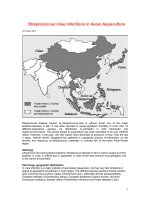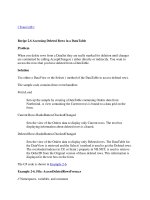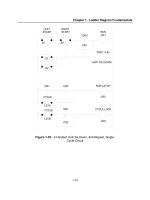Tài liệu Finite Difference Methods in Financial Engineering ppt
Bạn đang xem bản rút gọn của tài liệu. Xem và tải ngay bản đầy đủ của tài liệu tại đây (5.36 MB, 442 trang )
0470858826FM JWBK073-Duffy February 9, 2006 20:25 Char Count= 0
Finite Difference Methods
in Financial Engineering
A Partial Differential Equation Approach
Daniel J. Duffy
iii
0470858826c17 JWBK073-Duffy February 1, 2006 20:9 Char Count= 0
192
0470858826FM JWBK073-Duffy February 9, 2006 20:25 Char Count= 0
Finite Difference Methods
in Financial Engineering
i
0470858826FM JWBK073-Duffy February 9, 2006 20:25 Char Count= 0
For other titles in the Wiley Finance Series
please see www.wiley.com/finance
ii
0470858826FM JWBK073-Duffy February 9, 2006 20:25 Char Count= 0
Finite Difference Methods
in Financial Engineering
A Partial Differential Equation Approach
Daniel J. Duffy
iii
0470858826FM JWBK073-Duffy February 9, 2006 20:25 Char Count= 0
Copyright
C
2006 Daniel J. Duffy
Published by John Wiley & Sons Ltd, The Atrium, Southern Gate, Chichester,
West Sussex PO19 8SQ, England
Telephone (+44) 1243 779777
Email (for orders and customer service enquiries):
Visit our Home Page on www.wiley.com
All Rights Reserved. No part of this publication may be reproduced, stored in a retrieval system
or transmitted in any form or by any means, electronic, mechanical, photocopying, recording,
scanning or otherwise, except under the terms of the Copyright, Designs and Patents Act 1988
or under the terms of a licence issued by the Copyright Licensing Agency Ltd, 90 Tottenham
Court Road, London W1T 4LP, UK, without the permission in writing of the Publisher.
Requests to the Publisher should be addressed to the Permissions Department, John Wiley &
Sons Ltd, The Atrium, Southern Gate, Chichester, West Sussex PO19 8SQ, England, or emailed
to , or faxed to (+44) 1243 770620.
Designations used by companies to distinguish their products are often claimed as trademarks. All brand
names and product names used in this book are trade names, service marks, trademarks or registered
trademarks of their respective owners. The Publisher is not associated with any product or vendor
mentioned in this book.
This publication is designed to provide accurate and authoritative information in regard to
the subject matter covered. It is sold on the understanding that the Publisher is not engaged
in rendering professional services. If professional advice or other expert assistance is
required, the services of a competent professional should be sought.
Other Wiley Editorial Offices
John Wiley & Sons Inc., 111 River Street, Hoboken, NJ 07030, USA
Jossey-Bass, 989 Market Street, San Francisco, CA 94103-1741, USA
Wiley-VCH Verlag GmbH, Boschstr. 12, D-69469 Weinheim, Germany
John Wiley & Sons Australia Ltd, 42 McDougall Street, Milton, Queensland 4064, Australia
John Wiley & Sons (Asia) Pte Ltd, 2 Clementi Loop #02-01, Jin Xing Distripark, Singapore 129809
John Wiley & Sons Canada Ltd, 22 Worcester Road, Etobicoke, Ontario, Canada M9W 1L1
Wiley also publishes its books in a variety of electronic formats. Some content that appears
in print may not be available in electronic books.
Library of Congress Cataloguing-in-Publication Data
Duffy, Daniel J.
Finite difference methods in financial engineering : a partial differential equation approach / Daniel J. Duffy.
p. cm.
ISBN-13: 978-0-470-85882-0
ISBN-10: 0-470-85882-6
1. Financial engineering—Mathematics. 2. Derivative securities—Prices—Mathematical models.
3. Finite differences. 4. Differential equations, Partial—Numerical solutions. I. Title.
HG176.7.D84 2006
332.01
51562—dc22
2006001397
British Library Cataloguing in Publication Data
A catalogue record for this book is available from the British Library
ISBN 13 978-0-470-85882-0 (HB)
ISBN 10 0-470-85882-6 (HB)
Typeset in 10/12pt Times by TechBooks, New Delhi, India
Printed and bound in Great Britain by Antony Rowe Ltd, Chippenham, Wiltshire
This book is printed on acid-free paper responsibly manufactured from sustainable forestry
in which at least two trees are planted for each one used for paper production.
iv
0470858826FM JWBK073-Duffy February 9, 2006 20:25 Char Count= 0
Contents
0 Goals of this Book and Global Overview 1
0.1 What is this book? 1
0.2 Why has this book been written? 2
0.3 For whom is this book intended? 2
0.4 Why should I read this book? 2
0.5 The structure of this book 3
0.6 What this book does not cover 4
0.7 Contact, feedback and more information 4
PART I THE CONTINUOUS THEORY OF PARTIAL
DIFFERENTIAL EQUATIONS 5
1 An Introduction to Ordinary Differential Equations 7
1.1 Introduction and objectives 7
1.2 Two-point boundary value problem 8
1.2.1 Special kinds of boundary condition 8
1.3 Linear boundary value problems 9
1.4 Initial value problems 10
1.5 Some special cases 10
1.6 Summary and conclusions 11
2 An Introduction to Partial Differential Equations 13
2.1 Introduction and objectives 13
2.2 Partial differential equations 13
2.3 Specialisations 15
2.3.1 Elliptic equations 15
2.3.2 Free boundary value problems 17
2.4 Parabolic partial differential equations 18
2.4.1 Special cases 20
2.5 Hyperbolic equations 20
2.5.1 Second-order equations 20
2.5.2 First-order equations 21
v
0470858826FM JWBK073-Duffy February 9, 2006 20:25 Char Count= 0
vi Contents
2.6 Systems of equations 22
2.6.1 Parabolic systems 22
2.6.2 First-order hyperbolic systems 22
2.7 Equations containing integrals 23
2.8 Summary and conclusions 24
3 Second-Order Parabolic Differential Equations 25
3.1 Introduction and objectives 25
3.2 Linear parabolic equations 25
3.3 The continuous problem 26
3.4 The maximum principle for parabolic equations 28
3.5 A special case: one-factor generalised Black–Scholes models 29
3.6 Fundamental solution and the Green’s function 30
3.7 Integral representation of the solution of parabolic PDEs 31
3.8 Parabolic equations in one space dimension 33
3.9 Summary and conclusions 35
4 An Introduction to the Heat Equation in One Dimension 37
4.1 Introduction and objectives 37
4.2 Motivation and background 38
4.3 The heat equation and financial engineering 39
4.4 The separation of variables technique 40
4.4.1 Heat flow in a road with ends held at constant temperature 42
4.4.2 Heat flow in a rod whose ends are at a specified
variable temperature 42
4.4.3 Heat flow in an infinite rod 43
4.4.4 Eigenfunction expansions 43
4.5 Transformation techniques for the heat equation 44
4.5.1 Laplace transform 45
4.5.2 Fourier transform for the heat equation 45
4.6 Summary and conclusions 46
5 An Introduction to the Method of Characteristics 47
5.1 Introduction and objectives 47
5.2 First-order hyperbolic equations 47
5.2.1 An example 48
5.3 Second-order hyperbolic equations 50
5.3.1 Numerical integration along the characteristic lines 50
5.4 Applications to financial engineering 53
5.4.1 Generalisations 55
5.5 Systems of equations 55
5.5.1 An example 57
5.6 Propagation of discontinuities 57
5.6.1 Other problems 58
5.7 Summary and conclusions 59
0470858826FM JWBK073-Duffy February 9, 2006 20:25 Char Count= 0
Contents vii
PART II FINITE DIFFERENCE METHODS: THE FUNDAMENTALS 61
6 An Introduction to the Finite Difference Method 63
6.1 Introduction and objectives 63
6.2 Fundamentals of numerical differentiation 63
6.3 Caveat: accuracy and round-off errors 65
6.4 Where are divided differences used in instrument pricing? 67
6.5 Initial value problems 67
6.5.1 Pad´e matrix approximations 68
6.5.2 Extrapolation 71
6.6 Nonlinear initial value problems 72
6.6.1 Predictor–corrector methods 73
6.6.2 Runge–Kutta methods 74
6.7 Scalar initial value problems 75
6.7.1 Exponentially fitted schemes 76
6.8 Summary and conclusions 76
7 An Introduction to the Method of Lines 79
7.1 Introduction and objectives 79
7.2 Classifying semi-discretisation methods 79
7.3 Semi-discretisation in space using FDM 80
7.3.1 A test case 80
7.3.2 Toeplitz matrices 82
7.3.3 Semi-discretisation for convection-diffusion problems 82
7.3.4 Essentially positive matrices 84
7.4 Numerical approximation of first-order systems 85
7.4.1 Fully discrete schemes 86
7.4.2 Semi-linear problems 87
7.5 Summary and conclusions 89
8 General Theory of the Finite Difference Method 91
8.1 Introduction and objectives 91
8.2 Some fundamental concepts 91
8.2.1 Consistency 93
8.2.2 Stability 93
8.2.3 Convergence 94
8.3 Stability and the Fourier transform 94
8.4 The discrete Fourier transform 96
8.4.1 Some other examples 98
8.5 Stability for initial boundary value problems 99
8.5.1 Gerschgorin’s circle theorem 100
8.6 Summary and conclusions 101
9 Finite Difference Schemes for First-Order Partial Differential Equations 103
9.1 Introduction and objectives 103
9.2 Scoping the problem 103
0470858826FM JWBK073-Duffy February 9, 2006 20:25 Char Count= 0
viii Contents
9.3 Why first-order equations are different: Essential difficulties 105
9.3.1 Discontinuous initial conditions 106
9.4 A simple explicit scheme 106
9.5 Some common schemes for initial value problems 108
9.5.1 Some other schemes 110
9.6 Some common schemes for initial boundary value problems 110
9.7 Monotone and positive-type schemes 110
9.8 Extensions, generalisations and other applications 111
9.8.1 General linear problems 112
9.8.2 Systems of equations 112
9.8.3 Nonlinear problems 114
9.8.4 Several independent variables 114
9.9 Summary and conclusions 115
10 FDM for the One-Dimensional Convection–Diffusion Equation 117
10.1 Introduction and objectives 117
10.2 Approximation of derivatives on the boundaries 118
10.3 Time-dependent convection–diffusion equations 120
10.4 Fully discrete schemes 120
10.5 Specifying initial and boundary conditions 121
10.6 Semi-discretisation in space 121
10.7 Semi-discretisation in time 122
10.8 Summary and conclusions 122
11 Exponentially Fitted Finite Difference Schemes 123
11.1 Introduction and objectives 123
11.2 Motivating exponential fitting 123
11.2.1 ‘Continuous’ exponential approximation 124
11.2.2 ‘Discrete’ exponential approximation 125
11.2.3 Where is exponential fitting being used? 128
11.3 Exponential fitting and time-dependent convection-diffusion 128
11.4 Stability and convergence analysis 129
11.5 Approximating the derivative of the solution 131
11.6 Special limiting cases 132
11.7 Summary and conclusions 132
PART III APPLYING FDM TO ONE-FACTOR INSTRUMENT PRICING 135
12 Exact Solutions and Explicit Finite Difference Method
for One-Factor Models 137
12.1 Introduction and objectives 137
12.2 Exact solutions and benchmark cases 137
12.3 Perturbation analysis and risk engines 139
12.4 The trinomial method: Preview 139
12.4.1 Stability of the trinomial method 141
12.5 Using exponential fitting with explicit time marching 142
12.6 Approximating the Greeks 142
0470858826FM JWBK073-Duffy February 9, 2006 20:25 Char Count= 0
Contents ix
12.7 Summary and conclusions 144
12.8 Appendix: the formula for Vega 144
13 An Introduction to the Trinomial Method 147
13.1 Introduction and objectives 147
13.2 Motivating the trinomial method 147
13.3 Trinomial method: Comparisons with other methods 149
13.3.1 A general formulation 150
13.4 The trinomial method for barrier options 151
13.5 Summary and conclusions 152
14 Exponentially Fitted Difference Schemes for Barrier Options 153
14.1 Introduction and objectives 153
14.2 What are barrier options? 153
14.3 Initial boundary value problems for barrier options 154
14.4 Using exponential fitting for barrier options 154
14.4.1 Double barrier call options 156
14.4.2 Single barrier call options 156
14.5 Time-dependent volatility 156
14.6 Some other kinds of exotic options 157
14.6.1 Plain vanilla power call options 158
14.6.2 Capped power call options 158
14.7 Comparisons with exact solutions 159
14.8 Other schemes and approximations 162
14.9 Extensions to the model 162
14.10 Summary and conclusions 163
15 Advanced Issues in Barrier and Lookback Option Modelling 165
15.1 Introduction and objectives 165
15.2 Kinds of boundaries and boundary conditions 165
15.3 Discrete and continuous monitoring 168
15.3.1 What is discrete monitoring? 168
15.3.2 Finite difference schemes and jumps in time 169
15.3.3 Lookback options and jumps 170
15.4 Continuity corrections for discrete barrier options 171
15.5 Complex barrier options 171
15.6 Summary and conclusions 173
16 The Meshless (Meshfree) Method in Financial Engineering 175
16.1 Introduction and objectives 175
16.2 Motivating the meshless method 175
16.3 An introduction to radial basis functions 177
16.4 Semi-discretisations and convection–diffusion equations 177
16.5 Applications of the one-factor Black–Scholes equation 179
16.6 Advantages and disadvantages of meshless 180
16.7 Summary and conclusions 181
0470858826FM JWBK073-Duffy February 9, 2006 20:25 Char Count= 0
x Contents
17 Extending the Black–Scholes Model: Jump Processes 183
17.1 Introduction and objectives 183
17.2 Jump–diffusion processes 183
17.2.1 Convolution transformations 185
17.3 Partial integro-differential equations and financial applications 186
17.4 Numerical solution of PIDE: Preliminaries 187
17.5 Techniques for the numerical solution of PIDEs 188
17.6 Implicit and explicit methods 188
17.7 Implicit–explicit Runge–Kutta methods 189
17.8 Using operator splitting 189
17.9 Splitting and predictor–corrector methods 190
17.10 Summary and conclusions 191
PART IV FDM FOR MULTIDIMENSIONAL PROBLEMS 193
18 Finite Difference Schemes for Multidimensional Problems 195
18.1 Introduction and objectives 195
18.2 Elliptic equations 195
18.2.1 A self-adjoint elliptic operator 198
18.2.2 Solving the matrix systems 199
18.2.3 Exact solutions to elliptic problems 200
18.3 Diffusion and heat equations 202
18.3.1 Exact solutions to the heat equation 204
18.4 Advection equation in two dimensions 205
18.4.1 Initial boundary value problems 207
18.5 Convection–diffusion equation 207
18.6 Summary and conclusions 208
19 An Introduction to Alternating Direction Implicit and Splitting Methods 209
19.1 Introduction and objectives 209
19.2 What is ADI, really? 210
19.3 Improvements on the basic ADI scheme 212
19.3.1 The D’Yakonov scheme 212
19.3.2 Approximate factorization of operators 213
19.3.3 ADI classico for two-factor models 215
19.4 ADI for first-order hyperbolic equations 215
19.5 ADI classico and three-dimensional problems 217
19.6 The Hopscotch method 218
19.7 Boundary conditions 219
19.8 Summary and conclusions 221
20 Advanced Operator Splitting Methods: Fractional Steps 223
20.1 Introduction and objectives 223
20.2 Initial examples 223
20.3 Problems with mixed derivatives 224
20.4 Predictor–corrector methods (approximation correctors) 226
20.5 Partial integro-differential equations 227
0470858826FM JWBK073-Duffy February 9, 2006 20:25 Char Count= 0
Contents xi
20.6 More general results 228
20.7 Summary and conclusions 228
21 Modern Splitting Methods 229
21.1 Introduction and objectives 229
21.2 Systems of equations 229
21.2.1 ADI and splitting for parabolic systems 230
21.2.2 Compound and chooser options 231
21.2.3 Leveraged knock-in options 232
21.3 A different kind of splitting: The IMEX schemes 232
21.4 Applicability of IMEX schemes to Asian option pricing 234
21.5 Summary and conclusions 235
PART V APPLYING FDM TO MULTI-FACTOR INSTRUMENT PRICING 237
22 Options with Stochastic Volatility: The Heston Model 239
22.1 Introduction and objectives 239
22.2 An introduction to Ornstein–Uhlenbeck processes 239
22.3 Stochastic differential equations and the Heston model 240
22.4 Boundary conditions 241
22.4.1 Standard european call option 242
22.4.2 European put options 242
22.4.3 Other kinds of boundary conditions 242
22.5 Using finite difference schemes: Prologue 243
22.6 A detailed example 243
22.7 Summary and conclusions 246
23 Finite Difference Methods for Asian Options and Other ‘Mixed’ Problems 249
23.1 Introduction and objectives 249
23.2 An introduction to Asian options 249
23.3 My first PDE formulation 250
23.4 Using operator splitting methods 251
23.4.1 For sake of completeness: ADI methods for asian option PDEs 253
23.5 Cheyette interest models 253
23.6 New developments 254
23.7 Summary and conclusions 255
24 Multi-Asset Options 257
24.1 Introduction and objectives 257
24.2 A taxonomy of multi-asset options 257
24.2.1 Exchange options 260
24.2.2 Rainbow options 261
24.2.3 Basket options 262
24.2.4 The best and worst 263
24.2.5 Quotient options 263
24.2.6 Foreign equity options 264
24.2.7 Quanto options 264
0470858826FM JWBK073-Duffy February 9, 2006 20:25 Char Count= 0
xii Contents
24.2.8 Spread options 264
24.2.9 Dual-strike options 265
24.2.10 Out-perfomance options 265
24.3 Common framework for multi-asset options 265
24.4 An overview of finite difference schemes for multi-asset problems 266
24.5 Numerical solution of elliptic equations 267
24.6 Solving multi-asset Black–Scholes equations 269
24.7 Special guidelines and caveats 270
24.8 Summary and conclusions 271
25 Finite Difference Methods for Fixed-Income Problems 273
25.1 Introduction and objectives 273
25.2 An introduction to interest rate modelling 273
25.3 Single-factor models 274
25.4 Some specific stochastic models 276
25.4.1 The Merton model 277
25.4.2 The Vasicek model 277
25.4.3 Cox, Ingersoll and Ross (CIR) 277
25.4.4 The Hull–White model 277
25.4.5 Lognormal models 278
25.5 An introduction to multidimensional models 278
25.6 The thorny issue of boundary conditions 280
25.6.1 One-factor models 280
25.6.2 Multi-factor models 281
25.7 Introduction to approximate methods for interest rate models 282
25.7.1 One-factor models 282
25.7.2 Many-factor models 283
25.8 Summary and conclusions 283
PART VI FREE AND MOVING BOUNDARY VALUE PROBLEMS 285
26 Background to Free and Moving Boundary Value Problems 287
26.1 Introduction and objectives 287
26.2 Notation and definitions 287
26.3 Some preliminary examples 288
26.3.1 Single-phase melting ice 288
26.3.2 One-factor option modelling: American exercise style 289
26.3.3 Two-phase melting ice 290
26.3.4 The inverse Stefan problem 290
26.3.5 Two and three space dimensions 291
26.3.6 Oxygen diffusion 293
26.4 Solutions in financial engineering: A preview 293
26.4.1 What kinds of early exercise features? 293
26.4.2 What kinds of numerical techniques? 294
26.5 Summary and conclusions 294
0470858826FM JWBK073-Duffy February 9, 2006 20:25 Char Count= 0
Contents xiii
27 Numerical Methods for Free Boundary Value Problems:
Front-Fixing Methods 295
27.1 Introduction and objectives 295
27.2 An introduction to front-fixing methods 295
27.3 A crash course on partial derivatives 295
27.4 Functions and implicit forms 297
27.5 Front fixing for the heat equation 299
27.6 Front fixing for general problems 300
27.7 Multidimensional problems 300
27.8 Front fixing and American options 303
27.9 Other finite difference schemes 305
27.9.1 The method of lines and predictor–corrector 305
27.10 Summary and conclusions 306
28 Viscosity Solutions and Penalty Methods for American Option Problems 307
28.1 Introduction and objectives 307
28.2 Definitions and main results for parabolic problems 307
28.2.1 Semi-continuity 307
28.2.2 Viscosity solutions of nonlinear parabolic problems 308
28.3 An introduction to semi-linear equations and penalty method 310
28.4 Implicit, explicit and semi-implicit schemes 311
28.5 Multi-asset American options 312
28.6 Summary and conclusions 314
29 Variational Formulation of American Option Problems 315
29.1 Introduction and objectives 315
29.2 A short history of variational inequalities 316
29.3 A first parabolic variational inequality 316
29.4 Functional analysis background 318
29.5 Kinds of variational inequalities 319
29.5.1 Diffusion with semi-permeable membrane 319
29.5.2 A one-dimensional finite element approximation 320
29.6 Variational inequalities using Rothe’s methods 323
29.7 American options and variational inequalities 324
29.8 Summary and conclusions 324
PART VII DESIGN AND IMPLEMENTATION IN C++ 325
30 Finding the Appropriate Finite Difference Schemes for your Financial
Engineering Problem 327
30.1 Introduction and objectives 327
30.2 The financial model 328
30.3 The viewpoints in the continuous model 328
30.3.1 Payoff functions 329
30.3.2 Boundary conditions 330
30.3.3 Transformations 331
0470858826FM JWBK073-Duffy February 9, 2006 20:25 Char Count= 0
xiv Contents
30.4 The viewpoints in the discrete model 332
30.4.1 Functional and non-functional requirements 332
30.4.2 Approximating the spatial derivatives in the PDE 333
30.4.3 Time discretisation in the PDE 334
30.4.4 Payoff functions 334
30.4.5 Boundary conditions 335
30.5 Auxiliary numerical methods 335
30.6 New Developments 336
30.7 Summary and conclusions 336
31 Design and Implementation of First-Order Problems 337
31.1 Introduction and objectives 337
31.2 Software requirements 337
31.3 Modular decomposition 338
31.4 Useful C++ data structures 339
31.5 One-factor models 339
31.5.1 Main program and output 342
31.6 Multi-factor models 343
31.7 Generalisations and applications to quantitative finance 346
31.8 Summary and conclusions 347
31.9 Appendix: Useful data structures in C++ 348
32 Moving to Black–Scholes 353
32.1 Introduction and objectives 353
32.2 The PDE model 354
32.3 The FDM model 355
32.4 Algorithms and data structures 355
32.5 The C++ model 356
32.6 Test case: The two-dimensional heat equation 357
32.7 Finite difference solution 357
32.8 Moving to software and method implementation 358
32.8.1 Defining the continuous problem 358
32.8.2 Creating a mesh 358
32.8.3 Choosing a scheme 360
32.8.4 Termination criterion 361
32.9 Generalisations 361
32.9.1 More general PDEs 361
32.9.2 Other finite difference schemes 361
32.9.3 Flexible software solutions 361
32.10 Summary and conclusions 362
33 C++ Class Hierarchies for One-Factor and Two-Factor Payoffs 363
33.1 Introduction and objectives 363
33.2 Abstract and concrete payoff classes 364
33.3 Using payoff classes 367
33.4 Lightweight payoff classes 368
33.5 Super-lightweight payoff functions 369
0470858826FM JWBK073-Duffy February 9, 2006 20:25 Char Count= 0
Contents xv
33.6 Payoff functions for multi-asset option problems 371
33.7 Caveat: non-smooth payoff and convergence degradation 373
33.8 Summary and conclusions 374
Appendices 375
A1 An introduction to integral and partial integro-differential equations 375
A2 An introduction to the finite element method 393
Bibliography 409
Index 417
0470858826FM JWBK073-Duffy February 9, 2006 20:25 Char Count= 0
xvi
0470858826c0 JWBK073-Duffy January 18, 2006 21:40 Char Count= 0
0
Goals of this Book and Global Overview
0.1 WHAT IS THIS BOOK?
The goal of this book is to develop robust, accurate and efficient numerical methods to price a
number of derivative products in quantitative finance. We focus on one-factor and multi-factor
models for a wide range of derivative products such as options, fixed income products, interest
rate products and ‘real’ options. Due to the complexity of these products it is very difficult to
find exact or closed solutions for the pricing functions. Even if a closed solution can be found
it may be very difficult to compute. For this and other reasons we need to resort to approximate
methods. Our interest in this book lies in the application of the finite difference method (FDM)
to these problems.
This book is a thorough introduction to FDM and how to use it to approximate the various
kinds of partial differential equations for contingent claims such as:
r
One-factor European and American options
r
One-factor and two-factor barrier options with continuous and discrete monitoring
r
Multi-asset options
r
Asian options, continuous and discrete monitoring
r
One-factor and two-factor bond options
r
Interest rate models
r
The Heston model and stochastic volatility
r
Merton jump models and extensions to the Black–Scholes model.
Finite difference theory has a long history and has been applied for more than 200 years
to approximate the solutions of partial differential equations in the physical sciences and
engineering.
What is the relationship between FDM and financial engineering? To answer this ques-
tion we note that the behaviour of a stock (or some other underlying) can be described by
a stochastic differential equation. Then, a contingent claim that depends on the underlying
is modelled by a partial differential equation in combination with some initial and bound-
ary conditions. Solving this problem means that we have found the value for the contingent
claim.
Furthermore, we discuss finite difference and variational schemes that model free and mov-
ing boundaries. This is the style for exercising American options, and we employ a number of
new modelling techniques to locate the position of the free boundary.
Finally, we introduce and elaborate the theory of partial integro-differential equations
(PIDEs), their applications to financial engineering and their approximations by FDM. In
particular, we show how the basic Black–Scholes partial differential equation is augmented by
an integral term in order to model jumps (the Merton model). Finally, we provide worked-out
C++ code on the CD that accompanies this book.
1
0470858826c0 JWBK073-Duffy January 18, 2006 21:40 Char Count= 0
2 Finite Difference Methods in Financial Engineering
0.2 WHY HAS THIS BOOK BEEN WRITTEN?
There are a number of reasons why this book has been written. First, the author wanted to
produce a text that showed how to apply numerical methods (in this case, finite difference
schemes) to quantitative finance. Furthermore, it is important to justify the applicability of
the schemes rather than just rely on numerical recipes that are sometimes difficult to apply
to real problems. The second desire was to construct robust finite difference schemes for use
in financial engineering, creating algorithms that describe how to solve the discrete set of
equations that result from such schemes and then to map them to C++ code.
0.3 FOR WHOM IS THIS BOOK INTENDED?
This book is for quantitative analysts, financial engineers and others who are involved in
defining and implementing models for various kinds of derivatives products. No previous
knowledge of partial differential equations (PDEs) or of finite difference theory is assumed.
It is, however, assumed that you have some knowledge of financial engineering basics, such
as stochastic differential equations, Ito calculus, the Black–Scholes equation and derivative
pricing in general. This book will be of value to those financial engineers who use the binomial
and trinomial methods to price options, as these two methods are special cases of explicit finite
difference schemes. This book will also hopefully be employed by those engineers who use
simulation methods (for example, the Monte Carlo method) to price derivatives, and it is hoped
that the book will help to bridge the gap between the stochastics and PDE approaches.
Finally, this book could be interesting for mathematicians, physicists and engineers who
wish to see how a well-known branch of numerical analysis is applied to financial engineering.
The information in the book may even improve your job prospects!
0.4 WHY SHOULD I READ THIS BOOK?
In the author’s opinion, this is one ofthefirst self-contained introductions to the finite difference
method and its applications to derivatives pricing. The book introduces the theory of PDE and
FDM and their applications to quantitative finance, and can be used as a self-contained guide
to learning and discovering the most important finite difference schemes for derivative pricing
problems.
Some of the advantages of the approach and the resulting added value of the book are:
r
A defined process starting from the financial models through PDEs, FDM and algorithms
r
An application of robust, accurate and efficient finite difference schemes for derivatives
pricing applications.
This book is more than just a cookbook: it motivates why a method does or does not work and
you can learn from this knowledge in a meaningful way. This book is also a good companion
to my other book, Financial Instrument Pricing in C++ (Duffy, 2004). The algorithms in
the present book can be mapped to C++, the de-facto object-oriented language for financial
engineering applications
In short, it is hoped that this book will help you to master all the details needed for a good
understanding of FDM in your daily work.
0470858826c0 JWBK073-Duffy January 18, 2006 21:40 Char Count= 0
Goals of this Book and Global Overview 3
0.5 THE STRUCTURE OF THIS BOOK
The book has been partitioned into seven parts, each of which deals with one specific topic in
detail. Furthermore, each part contains material that is required by its successor. In general,
we interleave the parts by first discussing the theory (for example, basic finite difference
schemes) in a given part and then applying this theory to a problem in financial engineering.
This ‘separation of concerns’ approach promotes understandability of the material, and the
parts in the book discuss the following topics:
I. The Continuous Theory of Partial Differential Equations
II. Finite Difference Methods: the Fundamentals
III. Applying FDM to One-Factor Instrument Pricing
IV. FDM for Multidimensional Problems
V. Applying FDM to Multi-Factor Instrument Pricing
VI. Free and Moving Boundary Value Problems
VII. Design and Implementation in C++
Part I presents an introduction to partial differential equations (PDE). This theory may be
new for some readers and for this reason these equations are discussed in some detail. The
relevance of PDE to instrument pricing is that a contingent claim or derivative can be modelled
as an initial boundary value problem for a second-order parabolic partial differential equation.
The partial differential equation has one time variable and one or more space variables. The
focus in Part I is to develop enough mathematical theory to provide a basis for work on finite
differences.
Part II is an introduction to the finite difference method for a number of partial differential
equations that appear in instrument pricing problems. We learn FDM in the following way:
(1) We introduce the model PDEs for the heat, convection and convection–diffusion equations
and propose several important finite difference schemes to approximate them. In particular,
we discuss a number of schemes that are used in the financial engineering literature and we
also introduce some special schemes that work under a range of parameter values. In this part,
focus is on the practical application of FDM to parabolic partial differential equations in one
space variable.
Part III examines the partial differential equations that describe one-factor instrument
models and their approximation by the finite difference schemes. In particular, we concen-
trate on European options, barrier options and options with jumps, and propose several finite
difference schemes for such options. An important class of problems discussed in this part
is the class of barrier options with continuous or discrete monitoring and robust methods are
proposed for each case. Finally, we model the partial integro-differential equations (PIDEs)
that describe options with jumps, and we show how to approximate them by finite difference
schemes.
Part IV discusses how to define and use finite difference schemes for initial boundary value
problems in several space variables. First, we discuss ‘direct’ scheme where we discretise the
time and space dimensions simultaneously. This approach works well with problems in two
space dimensions but for problems in higher dimensions we may need to solve the problem as a
series of simpler problems. There are two main contenders: first, alternating direction implicit
(ADI) methods are popular in the financial engineering literature; second, we discuss operator
splitting methods (or the method of fractional steps) that have their origins in the former Soviet
Union. Finally, we discuss some modern developments in this area.
0470858826c0 JWBK073-Duffy January 18, 2006 21:40 Char Count= 0
4 Finite Difference Methods in Financial Engineering
Part V applies the results and schemes from Part IV to approximating some multi-factor
problems. In particular, we examine the Heston PDE with stochastic volatility, Asian options,
rainbow options and two-factor bond models and how to apply ADI and operator splitting
methods to them.
Part VI deals with instrument pricing problems with the so-called early exercise feature.
Mathematically, these problems fall under the umbrella of free and moving boundary value
problems. We concentrate on the theory of such problems and the application to one-factor
American options. We also discuss ADI method in conjunction with free boundaries.
Part VII contains a number of chapters that support the work in the previous parts of the
book. Here we address issues that are relevant to the design and implementation of the FDM
algorithms in the book. We provide hints, guidelines and C++ sources to help the reader to
make the transition to production code.
0.6 WHAT THIS BOOK DOES NOT COVER
This book is concerned with the application of the finite difference method to instrument
pricing. This viewpoint implies that we concentrate on a number of issues while neglecting
others. Thus, this book is not:
r
an introduction to numerical analysis
r
a guide to the theoretical foundations of the theory of finite differences
r
an introduction to instrument pricing
r
a full ‘production’ C++ course.
These problems are considered in detail in other books and will be discussed elsewhere.
0.7 CONTACT, FEEDBACK AND MORE INFORMATION
The author welcomes your feedback, comments and suggestions for improvement. As far as I
am aware, all typos and errors have been removed from the text, but some may have slipped
past unnoticed. Nevertheless, all errors are my responsibility.
I am a trainer and developer and my main professional interests are in quantitative finance,
computational finance and object-oriented programming. In my free time I enjoy judo and
studying foreign (natural) languages.
If you have any questions on this book, please do not hesitate to contact me at
0470858826c01 JWBK073-Duffy February 1, 2006 13:43 Char Count= 0
Part I
The Continuous Theory of Partial
Differential Equations
Differential Equations
5
0470858826c01 JWBK073-Duffy February 1, 2006 13:43 Char Count= 0
6









